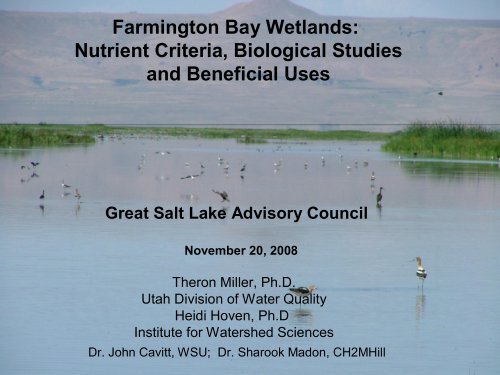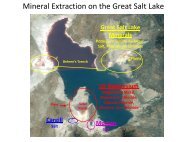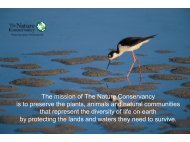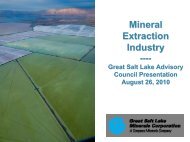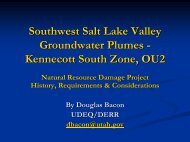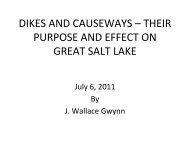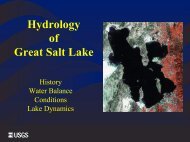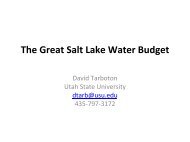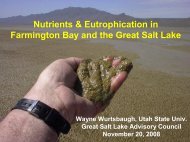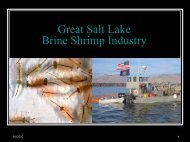Theron Miller, Division of Water Quality and Heidi Hoven, The ...
Theron Miller, Division of Water Quality and Heidi Hoven, The ...
Theron Miller, Division of Water Quality and Heidi Hoven, The ...
Create successful ePaper yourself
Turn your PDF publications into a flip-book with our unique Google optimized e-Paper software.
Farmington Bay Wetl<strong>and</strong>s:Nutrient Criteria, Biological Studies<strong>and</strong> Beneficial UsesGreat Salt Lake Advisory CouncilNovember 20, 2008<strong><strong>The</strong>ron</strong> <strong>Miller</strong>, Ph.D.Utah <strong>Division</strong> <strong>of</strong> <strong>Water</strong> <strong>Quality</strong><strong>Heidi</strong> <strong>Hoven</strong>, Ph.DInstitute for <strong>Water</strong>shed SciencesDr. John Cavitt, WSU; Dr. Sharook Madon, CH2MHill
ImpetusIn the Review <strong>of</strong> Utah’s 2002 303(d) List:• Environmental groups, academics <strong>and</strong> EPA challenged thatwe (Utah DEQ) do not assess beneficial uses <strong>of</strong> Great SaltLake or its associated wetl<strong>and</strong>s• Raised concerns about nutrient impacts to FarmingtonBay <strong>and</strong> its wetl<strong>and</strong>s
Where did We Start?• Needed a Source <strong>of</strong> Funding• Needed Technical Assistance• Needed Stakeholder “Buyin”
OBJECTIVESDEVELOP APPROPRIATE METHODOLOGY FORSITESPECIFIC NUTRIENT CRITERIA AND ASSOCIATEDMETHODOLOGY FOR BENEFICIAL USE ASSESSMENTAPPROACH• UNDERSTAND “HOW THE ECOSYSTEM WORKS”• IDENTIFY SENSITIVE HABITAT, SEASON AND FOODCHAIN LINKS• IDENTIFY (TOLERANCE) THRESHOLDS AMONG IMPORTANTECOSYSTEM COMPONENTS
FARMINGTON BAY TECHNICAL ADVISORY COMMITTEE•<strong><strong>The</strong>ron</strong> <strong>Miller</strong>, Chair, Limnologist, UDEQ•Ann Neville, Wetl<strong>and</strong> Scientist, Manager, ISSR, Kennecott•Nancy Keate, Wetl<strong>and</strong> Scientist, UDWR•Dennis Wenger, Wetl<strong>and</strong>s Scientist, Frontier Corporation•<strong>Heidi</strong> <strong>Hoven</strong>, Wetl<strong>and</strong>s Scientist, Institute for <strong>Water</strong>shed Sciences•Wayne Wurtsbaugh, Limnologist, USU•Amy Defreeze, Wetl<strong>and</strong>s Scientist, Utah Rivers Council•John Cavitt, Ornithologist, Weber State U•Don Paul, Ornithologist•Sam Rushforth, Phycologist, UVSU•Larry Gray, Entomologist, UVSC•Sharook Madon, Wetl<strong>and</strong>s Scientist, CH2MHill•Lel<strong>and</strong> Myers, P.E., Manager, CDSD•Florence Reynolds, SLC Public Utility•Ella Sorensen, ornithologist, National Audubon
<strong>Water</strong>fowl<strong>and</strong>shorebirdsAquatic lifein theirfood chainBeneficial Uses <strong>of</strong> GSLImportant feeding <strong>and</strong>nesting habitat formigratory birdsCorixidaeChironomidaeVariety <strong>of</strong> recreationalactivities
Farmington Bay Wetl<strong>and</strong>s Study20042006• Environmental Variables– <strong>Water</strong> <strong>Quality</strong>: (Nutrients, pH, TDS, D.O., TSS,temperature).– Soils: (pH, conductivity, nutrients, organicmatter).• Biotic Variables– Plants: (percent cover, height, speciescomposition, diversity, functional groups).– Macroinvertebrates: (species composition,relative abundance, diversity, functionalgroups).– Shorebirds: (nesting success, egg hatchability,foraging habitats)
Wetl<strong>and</strong> Sampling SitesReference Sheetflow <strong>and</strong>Impounded Wetl<strong>and</strong> SitesTest Sites
Shorebird Study ObjectivesNesting habitatNesting SuccessHatching successAquatic life in their food chain
Bear River Bird RefugeStomach contents by volumeAmerican avocetblack neck stilt
Nesting <strong>and</strong> Hatching Success
Impounded Wetl<strong>and</strong>sa) Upper PondP ercen t C o ver100.080.060.040.020.0AmbassadorFB WMANewstateISSRPSG0.0July Aug NovMonth
Conclusions Thus Far• Current sheetflow (sloped) vegetationindicators are not very sensitive to nutrientgradients– However, nesting/fledging habitat iscomprised <strong>of</strong> highly specific plantcharacteristics; <strong>and</strong>– Plant succession may be related to nutrientgradient.• Sheetflow <strong>and</strong> impounded wetl<strong>and</strong>macroinvertebrates are sensitive to nutrientgradients• However, waterfowl <strong>and</strong> shorebirds readilyforage on tolerant species <strong>and</strong> successfullynest in FB wetl<strong>and</strong>s• Early Senescence <strong>of</strong> SAV may constituteimpairment <strong>of</strong> beneficial use (waterfowl)
QUESTIONS?


